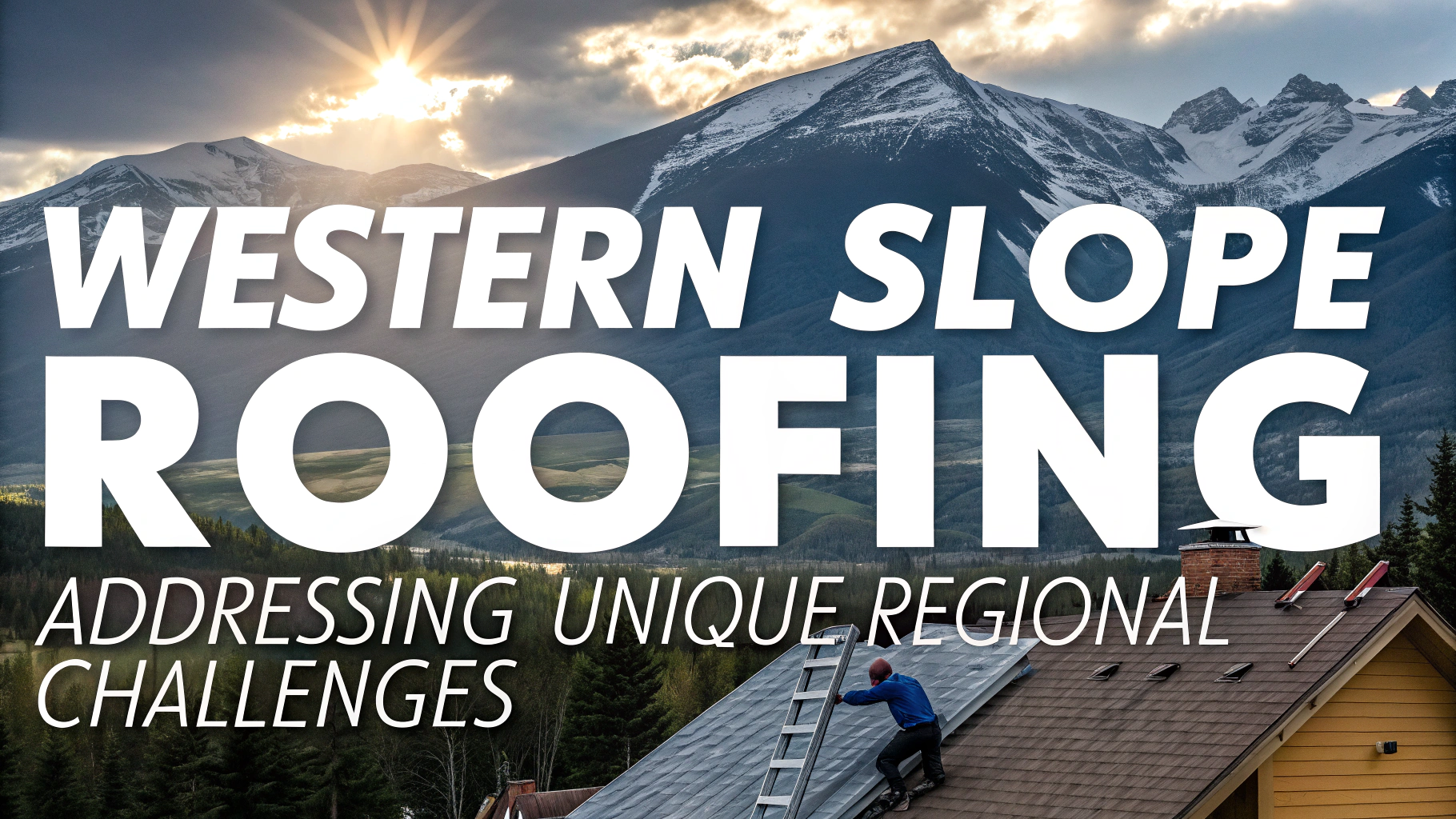The Western Slope of Colorado presents unique roofing challenges due to its distinct climate patterns and geographical features.
From intense UV exposure at higher elevations to dramatic temperature swings, roofing materials and installation techniques must be specifically adapted to withstand these regional conditions.
This guide explores proven solutions for Western Slope roofing projects, combining local expertise with practical advice for homeowners and contractors.
Regional Weather Impacts on Roofing
- Elevation: 4,000-14,000 feet above sea level
- Annual snowfall: 300+ inches in higher areas
- Temperature range: -30°F to 100°F
- UV exposure: 25% more intense than sea level
Recommended Roofing Materials
Impact-resistant Class 4 shingles stand up best to the frequent hail storms common to Colorado’s Western Slope.
- Metal Roofing: Excellent snow shedding properties
- Composite Shingles: High-grade materials rated for extreme weather
- Slate Tiles: Natural resistance to UV damage
- Cedar Shakes: Good insulation properties (require regular maintenance)
Snow Management Solutions
Proper snow management systems are essential for Western Slope roofs.
- Snow guards prevent dangerous snow slides
- Heated roof cables manage ice dam formation
- Enhanced ventilation systems reduce heat buildup
- Reinforced structural support handles heavy snow loads
Maintenance Schedule for Western Slope Roofs
| Season | Required Maintenance |
|---|---|
| Spring | Post-winter damage inspection, gutter cleaning |
| Summer | UV damage assessment, ventilation check |
| Fall | Pre-winter preparation, ice dam prevention |
| Winter | Snow load monitoring, ice dam inspection |
Local Code Requirements
Western Slope communities require specific wind ratings and snow load capacities for roofing materials.
- Wind resistance: Minimum 90 mph rating
- Snow load capacity: 40-100 psf depending on elevation
- Fire rating: Class A required in wildfire-prone areas
- Insulation: R-49 minimum for most locations
Finding Qualified Contractors
Select contractors with specific Western Slope experience and proper licensing.
- Check Colorado State Roofing License
- Verify local county certifications
- Request references from similar elevation projects
- Confirm insurance coverage for high-altitude work
Expert Tips for Long-Term Success
- Install extra ice and water shield at eaves
- Use high-altitude-rated underlayment
- Include additional ventilation points
- Select UV-resistant materials
- Plan for regular professional inspections
Resources and Support
Contact information for Western Slope roofing assistance:
- Colorado Roofing Association: (303) 484-0549
- Western Slope Contractors Association: (970) 245-1177
- Local Building Department Contacts: www.colorado.gov/building-departments
Cost Considerations
Western Slope roofing projects typically require higher budgets due to specialized materials and installation requirements.
- Material costs: 15-30% higher than front range prices
- Labor premiums for high-altitude work
- Additional snow management system expenses
- Enhanced underlayment and barrier costs
Environmental Adaptations
Successful Western Slope roofing requires specific adaptations to the mountain environment.
Altitude Considerations
- Special high-altitude fasteners
- Modified installation techniques
- Altitude-rated sealants and adhesives
- Enhanced drainage systems
Weather Protection
- Extended eave protection
- Enhanced valley materials
- Reinforced flashing systems
- Weather-resistant ventilation ports
Building for the Future
Investing in quality roofing solutions for the Western Slope means combining traditional expertise with modern innovations.
- Regular maintenance extends roof life by 25-40%
- Professional inspections prevent major repairs
- Quality materials provide long-term value
- Proper installation ensures warranty coverage
- Local expertise guarantees regional compliance
Securing Your Mountain Investment
The unique challenges of Western Slope roofing demand specialized knowledge, quality materials, and expert installation. By following regional best practices and maintaining regular care, property owners can ensure their roofs withstand the demanding mountain environment for years to come.
- Choose materials suited to elevation and climate
- Work with experienced local contractors
- Implement comprehensive maintenance plans
- Stay current with regional building codes
- Plan for long-term durability and performance
FAQs
- What unique challenges do Western Slope roofs face compared to other regions?
Western Slope roofs face extreme temperature fluctuations, heavy snowfall, intense UV exposure at higher altitudes, and frequent freeze-thaw cycles that can cause premature roof deterioration and ice dam formation. - Which roofing materials are best suited for Western Slope’s climate?
Impact-resistant asphalt shingles, metal roofing, and concrete tiles perform well in this region, as they can withstand heavy snow loads, intense sun exposure, and extreme temperature variations. - How often should Western Slope homeowners inspect their roofs?
Homeowners should conduct visual inspections twice yearly – in spring after snow melt and fall before winter – plus additional inspections following severe weather events. - What role does proper ventilation play in Western Slope roofing?
Proper ventilation is crucial for preventing ice dam formation, reducing moisture buildup, and maintaining consistent attic temperatures, which is especially important given the region’s significant temperature variations. - How can homeowners prevent ice dam formation on Western Slope roofs?
Install proper insulation and ventilation, use heat cables in problem areas, remove snow accumulation when possible, and ensure gutters are clean and properly maintained. - What impact does the high altitude have on roofing materials?
Higher altitude means increased UV exposure, which can accelerate shingle deterioration and material aging. UV-resistant materials and proper installation techniques are essential. - Why is snow load calculation important for Western Slope roofs?
Accurate snow load calculations ensure the roof structure can safely support heavy snow accumulation common in the region, preventing potential collapse and structural damage. - How should gutters be maintained in Western Slope’s climate?
Gutters require regular cleaning, particularly in fall before winter, and should be properly secured to handle heavy snow and ice. Heat cables may be necessary in problem areas. - What warranty considerations are important for Western Slope roofing?
Look for warranties that specifically cover high-altitude conditions, extreme weather events, and UV damage, as standard warranties may not adequately protect against regional challenges. - How do wind patterns affect roofing choices in the Western Slope?
The region’s strong winds require enhanced installation techniques, proper fastening systems, and wind-resistant materials rated for local conditions.
